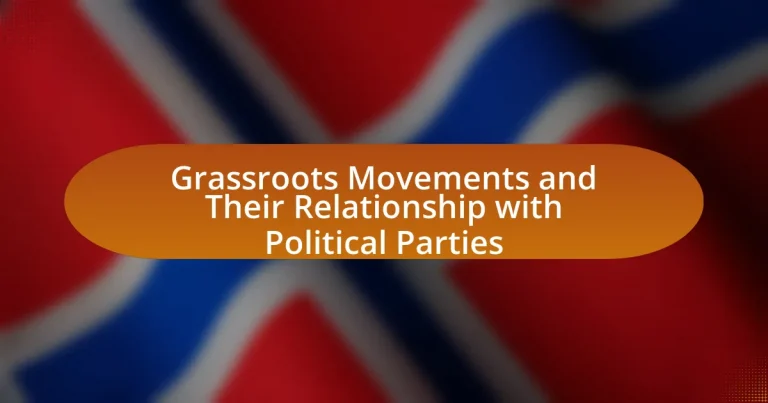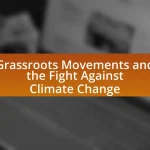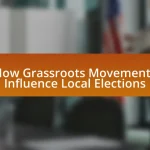Grassroots movements are organized efforts by ordinary individuals aimed at achieving social or political change at the community level, often emerging in response to social injustices, economic disparities, or political disenfranchisement. This article explores the origins, characteristics, and significance of grassroots movements, highlighting their role in influencing public opinion and policy change. It also examines the complex relationship between grassroots movements and political parties, including the challenges and strategies involved in collaboration. Key case studies, such as the Civil Rights Movement, illustrate effective partnerships and the impact of grassroots activism on political agendas. Additionally, the article discusses future trends, particularly the influence of technology and social media on grassroots mobilization and political engagement.
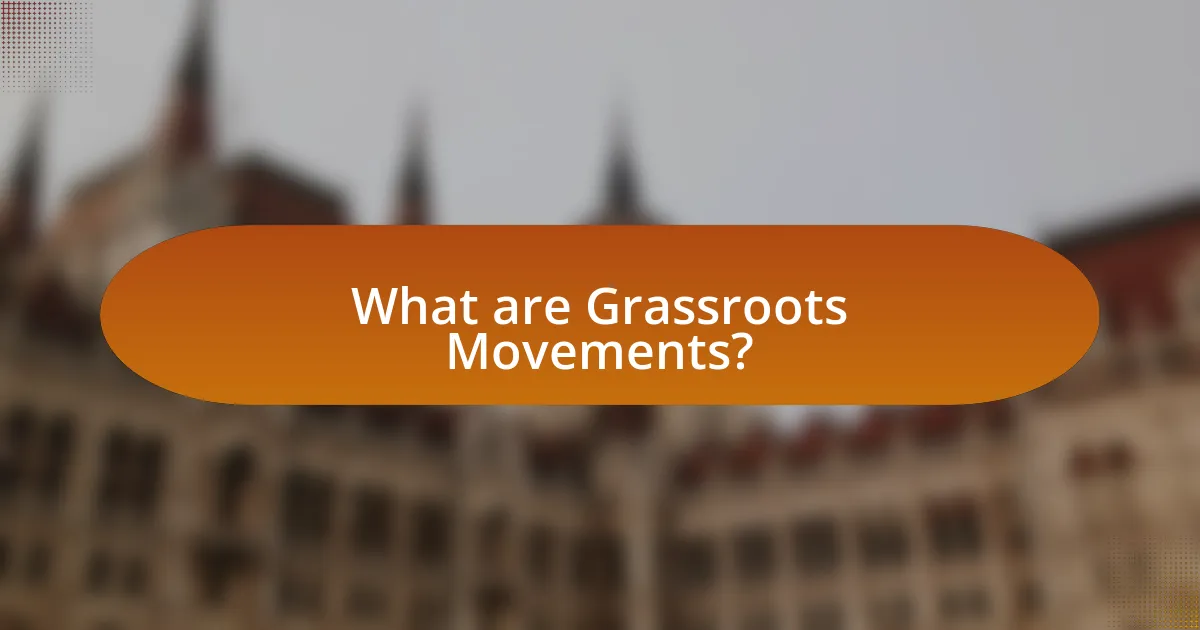
What are Grassroots Movements?
Grassroots movements are organized efforts by ordinary people to effect social or political change at the community level. These movements typically arise from the collective action of individuals who share common interests or grievances, often mobilizing around issues such as environmental protection, social justice, or political reform. For example, the Civil Rights Movement in the United States during the 1960s exemplifies a grassroots effort that significantly influenced national policy and societal norms. Grassroots movements often rely on local engagement and volunteer participation, distinguishing them from top-down approaches typically associated with established political parties.
How do Grassroots Movements originate?
Grassroots movements originate from the collective actions of individuals who share common interests or grievances, often in response to social, political, or economic issues. These movements typically emerge when a group of people feels marginalized or unheard by traditional political structures, prompting them to organize at the community level to advocate for change. Historical examples include the Civil Rights Movement in the United States, which arose from widespread racial injustice and mobilized ordinary citizens to demand equal rights. Such movements often leverage social media and local networks to amplify their message and gain support, demonstrating their ability to influence political discourse and policy.
What social conditions foster the emergence of Grassroots Movements?
Grassroots movements emerge primarily in response to social injustices, economic disparities, and political disenfranchisement. These conditions create a sense of urgency and collective identity among individuals who feel marginalized or oppressed. For instance, the Civil Rights Movement in the United States during the 1960s arose from systemic racism and economic inequality, mobilizing communities to demand equal rights and justice. Additionally, widespread social media access has facilitated the organization and mobilization of grassroots movements, as seen in the Arab Spring, where citizens utilized platforms to coordinate protests against authoritarian regimes. These social conditions, characterized by inequality and a lack of representation, are critical in fostering grassroots activism.
How do community needs influence the formation of Grassroots Movements?
Community needs significantly influence the formation of grassroots movements by driving collective action around shared issues. When individuals within a community identify common challenges—such as economic inequality, social injustice, or environmental concerns—they often mobilize to address these issues collectively. For instance, the Civil Rights Movement in the United States emerged from the community’s need for racial equality and justice, leading to widespread activism and the establishment of organizations like the NAACP. This demonstrates that grassroots movements are often a direct response to unmet community needs, reflecting the urgency and importance of those needs in shaping collective efforts for change.
What are the key characteristics of Grassroots Movements?
Grassroots movements are characterized by their community-driven nature, emphasizing local participation and activism. These movements typically arise from the collective efforts of individuals at the local level, seeking to address specific social, political, or environmental issues. They often rely on volunteer efforts and grassroots organizing, which fosters a sense of ownership and empowerment among participants. Additionally, grassroots movements prioritize inclusivity and democratic decision-making, allowing diverse voices to contribute to the movement’s goals. Evidence of their effectiveness can be seen in historical examples such as the Civil Rights Movement in the United States, where local communities mobilized to challenge systemic injustices, leading to significant legislative changes.
How do Grassroots Movements differ from traditional political organizations?
Grassroots movements differ from traditional political organizations primarily in their structure and approach to mobilization. Grassroots movements are typically decentralized and rely on community engagement and participation, whereas traditional political organizations often have a hierarchical structure with formal leadership and established protocols. For example, grassroots movements like the Civil Rights Movement in the 1960s mobilized individuals at the community level to advocate for change, contrasting with traditional political organizations that operate through formal party systems and established political processes. This distinction highlights how grassroots movements prioritize direct action and local involvement over the formalities of traditional political frameworks.
What role does community engagement play in Grassroots Movements?
Community engagement is essential in grassroots movements as it fosters collective action and mobilizes individuals towards a common goal. Grassroots movements rely on the active participation of community members to identify issues, share resources, and advocate for change, which enhances the movement’s legitimacy and effectiveness. For instance, the Civil Rights Movement in the United States demonstrated how community engagement through local organizing and participation led to significant legislative changes, such as the Civil Rights Act of 1964. This historical example illustrates that when communities are engaged, they can effectively challenge systemic injustices and influence political outcomes.
Why are Grassroots Movements important in the political landscape?
Grassroots movements are important in the political landscape because they empower ordinary citizens to influence political processes and advocate for social change. These movements often arise from community-level concerns and mobilize individuals to engage in activism, thereby amplifying voices that may be overlooked by traditional political institutions. For instance, the Civil Rights Movement in the United States, which was largely driven by grassroots organizing, led to significant legislative changes such as the Civil Rights Act of 1964. This demonstrates how grassroots efforts can effectively challenge systemic injustices and shape public policy.
How do Grassroots Movements impact policy change?
Grassroots movements significantly impact policy change by mobilizing community members to advocate for specific issues, thereby influencing political agendas. These movements often raise awareness about social injustices, environmental concerns, or economic inequalities, compelling policymakers to address these issues. For instance, the Civil Rights Movement in the United States led to landmark legislation such as the Civil Rights Act of 1964, demonstrating how organized grassroots efforts can lead to substantial policy reforms. Additionally, grassroots movements utilize social media and community organizing to amplify their messages, creating pressure on elected officials to respond to constituents’ demands. This dynamic illustrates the power of collective action in shaping legislative outcomes and driving societal change.
What influence do Grassroots Movements have on public opinion?
Grassroots movements significantly influence public opinion by mobilizing community engagement and raising awareness on specific issues. These movements often utilize social media and local organizing to disseminate information, which can shift perceptions and attitudes among the general populace. For instance, the Black Lives Matter movement has effectively changed public discourse around racial justice, leading to increased support for police reform initiatives, as evidenced by a 2020 Gallup poll showing a rise in public concern over racial inequality. This demonstrates that grassroots movements can effectively shape and transform public opinion through sustained advocacy and community involvement.
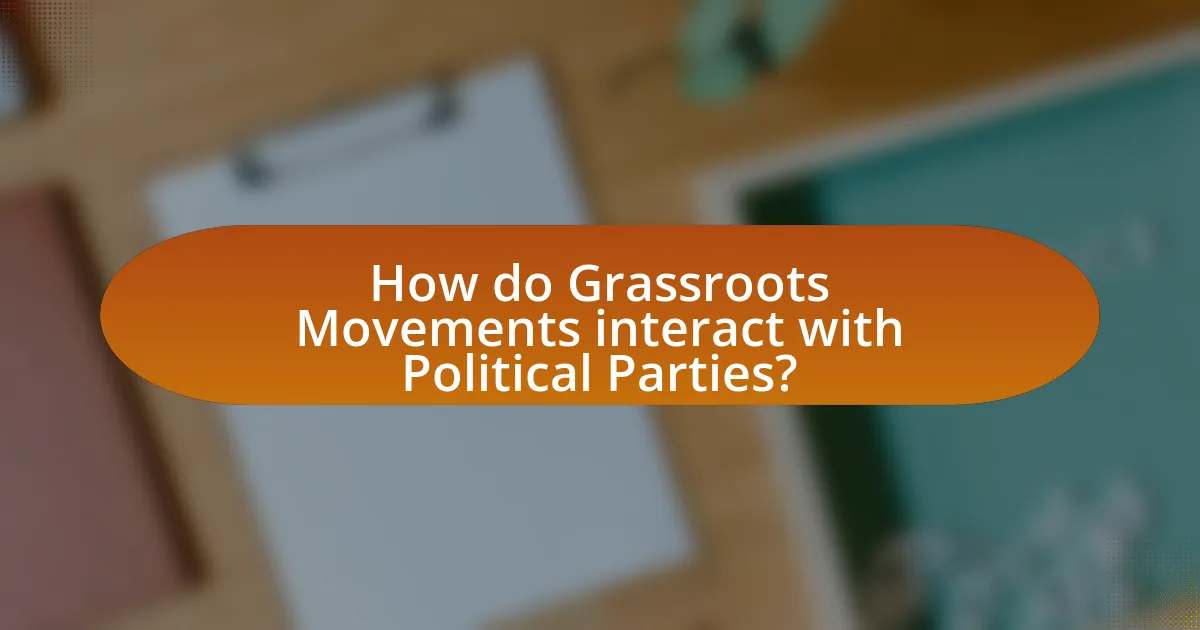
How do Grassroots Movements interact with Political Parties?
Grassroots movements interact with political parties primarily through advocacy, mobilization, and influence on policy agendas. These movements often emerge from community-level concerns and seek to raise awareness and drive change, which can attract the attention of political parties looking to align with popular sentiments. For instance, the Civil Rights Movement in the United States significantly influenced the Democratic Party’s platform in the 1960s, leading to the passage of landmark legislation like the Civil Rights Act of 1964. Additionally, grassroots movements can provide a base of support for political parties during elections, as seen with the Tea Party’s impact on the Republican Party in the late 2000s, where it energized the party’s base and shifted its focus towards limited government and fiscal conservatism. This interaction can lead to formal partnerships, where political parties may adopt the goals of grassroots movements into their platforms, thereby amplifying the movements’ messages and objectives.
What is the nature of the relationship between Grassroots Movements and Political Parties?
The relationship between grassroots movements and political parties is often characterized by mutual influence and interaction. Grassroots movements can mobilize public support and raise awareness on specific issues, which political parties may then adopt into their platforms to gain electoral advantage. For instance, the civil rights movement in the United States significantly influenced the Democratic Party’s policies in the 1960s, leading to the passage of landmark legislation like the Civil Rights Act. Conversely, political parties may also seek to co-opt grassroots movements to legitimize their agendas or to harness their organizational capabilities for electoral campaigns. This dynamic illustrates a complex interplay where grassroots movements can drive political change while political parties can provide a pathway for that change to be institutionalized within the political system.
How do Grassroots Movements influence the agendas of Political Parties?
Grassroots movements influence the agendas of political parties by mobilizing public support and advocating for specific issues that resonate with the electorate. These movements often highlight social, economic, or environmental concerns that may be overlooked by established political entities, compelling parties to adopt these issues into their platforms to remain relevant and appealing to voters. For instance, the Civil Rights Movement in the 1960s significantly pressured political parties to address racial equality, leading to landmark legislation such as the Civil Rights Act of 1964. This historical example illustrates how grassroots activism can shift party priorities and create lasting changes in political discourse.
What strategies do Political Parties use to engage with Grassroots Movements?
Political parties engage with grassroots movements through strategies such as coalition-building, community outreach, and leveraging social media. Coalition-building involves forming alliances with grassroots organizations to amplify shared goals, as seen in the collaboration between the Democratic Party and various environmental groups during climate change initiatives. Community outreach includes organizing local events and town halls to foster direct communication and gather feedback, which enhances voter engagement and trust. Additionally, leveraging social media platforms allows political parties to mobilize grassroots support quickly, exemplified by the use of Twitter and Facebook in the 2016 U.S. presidential election to rally supporters and disseminate information rapidly. These strategies demonstrate how political parties can effectively connect with grassroots movements to influence policy and mobilize voters.
What challenges do Grassroots Movements face when working with Political Parties?
Grassroots movements face significant challenges when collaborating with political parties, primarily due to differing priorities and goals. Political parties often prioritize electoral success and maintaining power, which can lead to the marginalization of grassroots issues that may not align with their broader agenda. For instance, grassroots movements advocating for social justice may find their specific demands diluted or ignored in favor of more mainstream political strategies. Additionally, there can be a lack of trust between grassroots activists and party officials, as activists may perceive parties as co-opting their movements for political gain rather than genuinely supporting their causes. This dynamic can hinder effective collaboration and limit the impact of grassroots initiatives within the political landscape.
How do ideological differences affect collaboration between Grassroots Movements and Political Parties?
Ideological differences significantly hinder collaboration between grassroots movements and political parties. Grassroots movements often prioritize social justice, environmental issues, or community empowerment, while political parties may focus on broader electoral strategies and compromise to gain wider support. This divergence can lead to mistrust, as grassroots activists may perceive political parties as co-opting their agendas for electoral gain, diluting their core messages. For instance, the Occupy Wall Street movement criticized political parties for failing to address economic inequality, which illustrates how differing priorities can create barriers to effective collaboration. Consequently, these ideological rifts can result in fragmented efforts, limiting the potential for unified action on shared goals.
What are the risks of co-optation for Grassroots Movements?
Co-optation poses significant risks for grassroots movements by undermining their original goals and diluting their message. When political parties or established organizations co-opt grassroots movements, they often redirect the movement’s focus towards mainstream agendas, which can lead to a loss of authenticity and grassroots support. For instance, the civil rights movement in the United States faced co-optation when mainstream political entities adopted its rhetoric while failing to address its core demands, resulting in a fragmented movement and diminished impact. This dynamic can also lead to disillusionment among grassroots activists, who may feel that their efforts are being exploited for political gain rather than genuine change.
How can Grassroots Movements effectively collaborate with Political Parties?
Grassroots movements can effectively collaborate with political parties by aligning their goals and strategies to create a unified agenda. This collaboration can be achieved through mutual engagement, where grassroots organizations actively participate in party platforms, influencing policy decisions and candidate selections. For instance, the collaboration between the grassroots organization MoveOn and the Democratic Party during election cycles demonstrates how grassroots movements can mobilize support and resources, leading to increased voter turnout and advocacy for specific issues. Such partnerships can enhance the political influence of grassroots movements while providing political parties with grassroots support and legitimacy.
What best practices can Grassroots Movements adopt for successful partnerships?
Grassroots movements can adopt several best practices for successful partnerships, including establishing clear communication, aligning goals, and fostering mutual respect. Clear communication ensures that all parties understand each other’s objectives and expectations, which is crucial for collaboration. Aligning goals helps to create a unified vision, making it easier to work together towards common outcomes. Fostering mutual respect builds trust and encourages open dialogue, which is essential for resolving conflicts and enhancing cooperation. Research indicates that successful partnerships often hinge on these foundational elements, as evidenced by case studies of effective grassroots initiatives that have successfully collaborated with political parties.
How can Grassroots Movements maintain their identity while working with Political Parties?
Grassroots movements can maintain their identity while working with political parties by establishing clear boundaries and prioritizing their core values. By defining specific goals that align with their mission, grassroots movements can ensure that their unique perspectives and community-driven initiatives are not overshadowed by the political party’s agenda. For instance, the Civil Rights Movement in the United States successfully collaborated with political entities while retaining its focus on social justice and equality, demonstrating that maintaining a distinct identity is possible through strategic partnerships. This approach allows grassroots movements to influence political discourse without compromising their foundational principles.
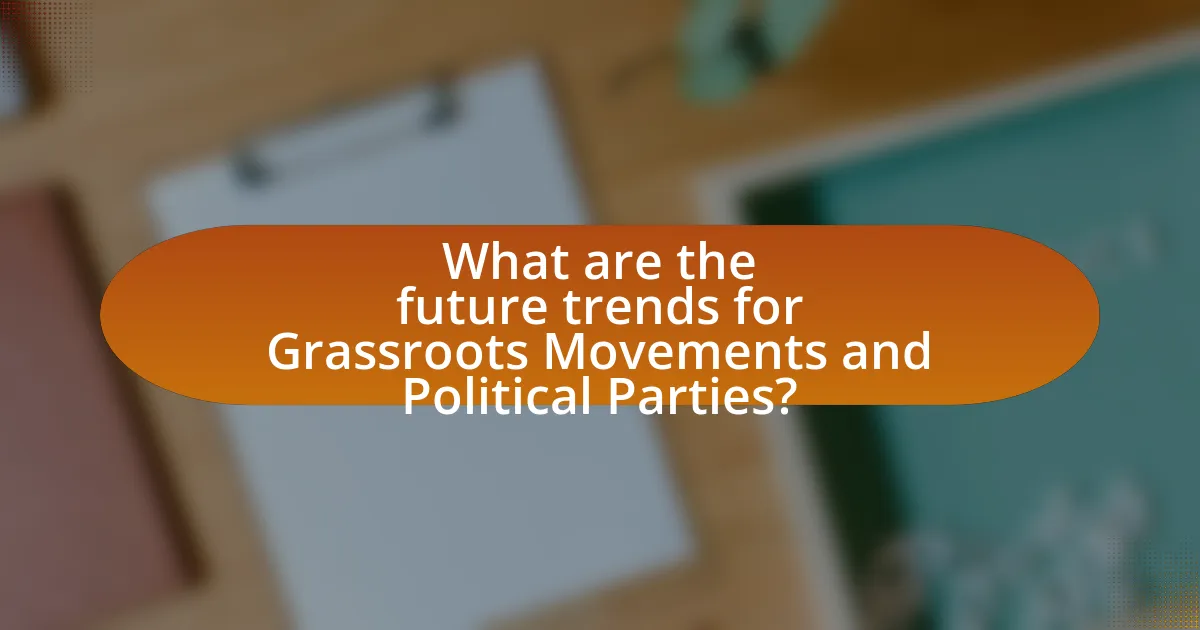
What are the future trends for Grassroots Movements and Political Parties?
Future trends for grassroots movements and political parties indicate a growing integration of digital technology and social media to mobilize support and organize campaigns. This trend is evidenced by the increasing use of platforms like Twitter and Facebook, which have enabled grassroots movements to reach wider audiences and engage younger voters effectively. Additionally, there is a notable shift towards issue-based coalitions, where grassroots movements align with political parties on specific policies rather than traditional party loyalty, reflecting a demand for more responsive and accountable governance. This evolution is supported by data showing that movements like Black Lives Matter and climate activism have significantly influenced political agendas and party platforms in recent years.
How is technology shaping the relationship between Grassroots Movements and Political Parties?
Technology is significantly shaping the relationship between grassroots movements and political parties by facilitating communication, mobilization, and fundraising. Social media platforms enable grassroots movements to rapidly disseminate information, organize events, and engage supporters, which can influence political parties to adopt their agendas or respond to their demands. For instance, the use of Twitter and Facebook during the Arab Spring allowed grassroots activists to coordinate protests and gain international attention, prompting political parties to reconsider their positions on governance and reform. Additionally, crowdfunding platforms have empowered grassroots movements to raise funds independently, reducing their reliance on traditional party structures and altering the dynamics of political support. This shift has led to a more collaborative yet sometimes contentious relationship, as political parties must navigate the influence of these movements while maintaining their own agendas.
What role do social media platforms play in mobilizing Grassroots Movements?
Social media platforms play a crucial role in mobilizing grassroots movements by facilitating rapid communication, organization, and outreach among supporters. These platforms enable activists to share information, coordinate events, and rally support quickly, often leading to significant participation in protests and campaigns. For instance, the Arab Spring demonstrated how social media was instrumental in organizing protests across multiple countries, allowing grassroots movements to gain momentum and visibility on a global scale. Additionally, studies have shown that social media can increase engagement and participation rates, with a report from the Pew Research Center indicating that 69% of adults in the U.S. use social media, making it a powerful tool for grassroots mobilization.
How can data analytics enhance the effectiveness of Grassroots Movements?
Data analytics can enhance the effectiveness of grassroots movements by enabling targeted outreach and informed decision-making. By analyzing demographic data, social media engagement, and community needs, grassroots organizations can identify key supporters and tailor their messaging to resonate with specific audiences. For instance, a study by the Pew Research Center found that data-driven campaigns can increase engagement rates by up to 50%, demonstrating the power of analytics in mobilizing supporters. Additionally, real-time data tracking allows movements to adapt strategies quickly based on feedback and changing circumstances, ultimately leading to more effective advocacy and resource allocation.
What lessons can be learned from successful Grassroots Movements?
Successful grassroots movements demonstrate the importance of community engagement and mobilization in effecting change. These movements often rely on local participation, which fosters a sense of ownership and accountability among members. For instance, the Civil Rights Movement in the United States effectively mobilized local communities to advocate for social justice, leading to significant legislative changes such as the Civil Rights Act of 1964. Additionally, successful grassroots movements highlight the necessity of clear messaging and strategic communication to unify supporters and attract broader attention. The Women’s March in 2017 exemplified this by effectively using social media to galvanize millions globally around issues of women’s rights and social justice. Furthermore, these movements often illustrate the power of coalition-building, as diverse groups can come together to amplify their voices and influence policy. The environmental movement, particularly the global climate strikes initiated by youth activists, showcases how collective action can pressure political entities to prioritize climate policies. Overall, successful grassroots movements teach that local engagement, clear communication, and coalition-building are critical components for achieving political and social objectives.
What case studies exemplify effective collaboration between Grassroots Movements and Political Parties?
One prominent case study exemplifying effective collaboration between grassroots movements and political parties is the Civil Rights Movement in the United States during the 1960s. Grassroots organizations, such as the Student Nonviolent Coordinating Committee (SNCC) and the Southern Christian Leadership Conference (SCLC), worked closely with political figures like President Lyndon B. Johnson to advocate for civil rights legislation. This collaboration led to the passage of the Civil Rights Act of 1964 and the Voting Rights Act of 1965, which were significant milestones in American history. The grassroots movements mobilized public support and highlighted injustices, while political parties facilitated legislative change, demonstrating a successful partnership that resulted in transformative social and political outcomes.
How can these lessons be applied to future movements?
Lessons from grassroots movements can be applied to future movements by emphasizing the importance of community engagement and coalition-building. Successful movements, such as the Civil Rights Movement, demonstrated that mobilizing local communities and forming alliances with established political parties can amplify voices and increase political influence. For instance, the collaboration between grassroots organizations and the Democratic Party during the 1960s led to significant legislative changes, including the Civil Rights Act of 1964. This historical context illustrates that future movements should prioritize grassroots organizing and strategic partnerships to effectively advocate for policy changes and social justice.
What practical steps can Grassroots Movements take to strengthen their political influence?
Grassroots movements can strengthen their political influence by building coalitions with like-minded organizations. Collaborating with other groups amplifies their voice and resources, as seen in the success of the Women’s March, which united various organizations to advocate for women’s rights and social justice. Additionally, grassroots movements should engage in voter mobilization efforts, as demonstrated by the 2018 midterm elections in the United States, where grassroots initiatives significantly increased voter turnout among young people and marginalized communities. Utilizing social media platforms effectively to spread their message and organize events can also enhance their reach, as evidenced by the viral campaigns of movements like Black Lives Matter. Finally, grassroots movements should focus on local issues that resonate with their communities, ensuring that their agendas align with the needs and concerns of the constituents they aim to represent.
